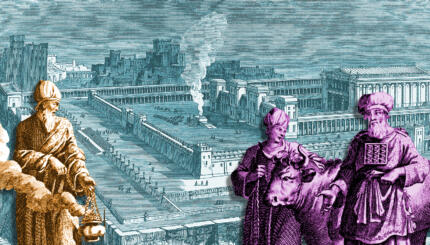Adapted from God in Your Body: Kabbalah, Mindfulness, and Embodied Spiritual Practice.
The practice of fasting evokes many of the worst associations with religion: asceticism, self denial, and fear of the body and its pleasures. Moreover, because most fasts in the Jewish tradition are associated with the destruction of the Temple (Yom Kippur being the most prominent exception), many liberal Jews see them as irrelevant or obsolete. Yet fasting has transformative potential, if we approach the practice from functional, rather than mythic, terms.
From Personal Rite to Communal Remembrance
Initially, this perspective was clearly the mainstream view in the Jewish tradition. The Bible generally regards fasting as a practice that works on the heart, usually as an individual expression of grief, prayer, or meditation. Yom Kippur is the most important of these spiritual fasts.
But fasting also appears as a mourning rite (II Samuel 1:12, 12:16-23), as part of revelation or prophecy (Exodus 34:28, I Samuel 28:20), as preparation for an important event (Judges 20:26, I Samuel 14:24), and as part of petitionary prayer (I Samuel 7:5-6, II Samuel 12) or repentance (Jonah 3:5, Jeremiah 36:9). There is also evidence of a little-discussed discipline of women voluntarily fasting (Numbers 30:14 and the apocryphal Judith 8:6), and many later examples of fasting as a preparation for visions (Daniel 10:2-3, and several apocryphal books). And there are instances of fasting as, essentially, magic (Judges 20:26, Joel 1:14, Jonah 3:5-10). In all these contexts, fasting is regarded for what it does, not what it signifies or observes.

Help us keep Jewish knowledge accessible to millions of people around the world.
Your donation to My Jewish Learning fuels endless journeys of Jewish discovery. With your help, My Jewish Learning can continue to provide nonstop opportunities for learning, connection and growth.
Later, however, the effects of fasts became secondary to their historical and social significance. In the “Zechariah fasts” that were later made part of Jewish law, that significance is the destruction of the Temple in Jerusalem.
As Eliezer Diamond has shown in his book Holy Men and Hunger Artists, talmudic rabbis often took up fasting as an ongoing discipline, but as Diamond also shows, mourning the destruction of the Temple was almost always provided as a rationale. Perhaps the Temple was but a pretext for an ascetic practice the rabbis wanted to take on; there is certainly evidence for that view, and fasting remains to this day a common practice among the pious.
But today, if you look at a traditional Jewish explanation of “why we fast,” this is what you’ll learn about the fasts: not their effects but their historical “reasons.” So, we are told, we fast on Tisha B’Av to commemorate the destruction of both the First (in 586 B.C.E.) and the Second (in 70 C.E.) Temples in Jerusalem. We fast on the 17th of Tammuz, three weeks earlier, to commemorate the breaking of the gates of Jerusalem by the Romans in 70 C.E.
Effects Instead of Reasons
Now, however, these historical rationales often cause more harm than good. Personally, I have struggled for decades to connect in a meaningful way with the destruction of the two Temples. True, these catastrophes are the halakhic basis of all the public fast days except Yom Kippur. True, they were massive upheavals that caused widespread suffering and death. And, yes, the Temple was seen as the connecting point between heaven and earth; the earthly dwelling place of the divine presence; and the geographical, political, and spiritual center of the Jewish people. The tears of exile, from the Crusades to the Holocaust, all flow from the wound of its destruction.
But these reasons are also distant–chronologically, theologically, and above all emotionally. In fact, I have found the effects of fasting on body, heart, mind, and spirit are far more powerful than the reason the fast may have been instituted by rabbis two thousand years ago.
First, occasional fasting can be good for the body. It is a healthy way to “clean out the system” of toxins that have accumulated. There can be, at the end of a fast, a powerful sense of catharsis. Sometimes I feel like I’ve sweat out the garbage from the industrialized food I’ve been eating, and I’ve cried out the accumulated grime of the emotions I’ve been ignoring. It is a primal, embodied act, which makes as little sense as does love, passion, or beauty.
Second, on the emotional plane, fasts are like vacations from the pursuit of pleasure. Sometimes the appetites and desires of the physical body really can become our masters, rather than our servants; without getting carried away, it’s useful to think about fasting as correctives at such times. As a lifestyle, denying ourselves the pleasures of the world is anti-spiritual and anti-Jewish: God lives in manifestation, and our souls are attuned to wonder. But as an occasional practice — such as the six days a year prescribed by halakhah — it’s a welcome break.
It’s as if I say: This day, I’m not worried about feeling good. In fact, I’m going to let myself not feel good. Supported by my community, I’m going to set aside these six days a year for reflection, introspection, even outright mourning. I don’t flip a switch (one day happy, the next sad), but I do invite in whatever emotions might ordinarily be beneath my cognitive radar.The most profound effect of fasting, though, is on the level of the mind. For those who have difficulty meditating, I recommend fasting. Denying the body food reduces the amount of energy available to the brain, and so it becomes increasingly difficult, as the day wears on, to think in the usual, linear ways. You lose track of lists, you get frustrated trying to plan. All the routine activities of the thinking mind get disrupted, which is why it’s such a waste to try to have a “normal” day during a fast.
Fasting is an opportunity: the momentum of thought decreases, and you become quite satisfied just to be here now. This, of course, is just what meditation does also: slow down the train of thought so that we can actually see the world (internal and external) more clearly. Fasting makes meditation easier; if meditation is like biking up a steep slope of thought, then meditating while fasting is like biking downhill. Try it for yourself: sit for 45 minutes toward the end of a fast day, and see how much easier it is, as the quantity and intensity of distracting thoughts markedly diminishes.
It’s no wonder, then, that fasting has been part of contemplative, prophetic, and even magical practices from the Bible to the present day. It’s not that the altered state is enlightenment or devekut. Rather, in a concentrated mindstate (known in Sanskrit as samadhi), it’s easier to see what you’re looking for. None of this is magic; it’s simple, and biological. But as long as these provisos are borne in mind, fasting and samadhi can show you the way. Thus fasting leads even to the fourth plane of reality, atzilut (emanation), not because the concentrated mind is itself the ultimate reality, but because, in a concentrated state, the mind can visit territories otherwise beyond our ken.
Finding Meaning in Traditional Fasts
Why, then, fast on these six days, rather than whenever the inspiration is present? First, I draw strength from the knowledge that hundreds of thousands of people are also fasting on this communal day — even if my reading of the day’s significance is different from theirs. Jews have never agreed on why we do anything; we have four New Year’s, and three names for the Passover holiday. Yet community is built by doing.
Second, and related, is the aspect of humility in spiritual practice. Every year, I learn from the tradition, even if my relationship to it is no longer as orthodox as it once was. Perhaps I’ll explore the social meaning of fasting–what depriving the body might have meant in a culture where food was not taken for granted. Or I’ll ponder what it means that ignoring the needs of the body is, itself, a sign of mourning. Every year, there is something new.
Finally, I approach the five Temple-related fast days in the spirit of spiritual practice, and practice requires form. If we only do something when we feel like doing it, it isn’t a practice. If you get up after ten minutes of meditation because you’re not feeling like meditating, then, in a way, you’re never meditating. The container is meant to be fixed, so that whatever transpires inside it can be as fluid, and open, as possible.
So I fast when the fast days fall. Sometimes, there is a wonderful congruence between observance and life. Other times, as when I recently observed Tisha B’Av while traveling through Norway, there isn’t. Allowing the fast to proceed, whatever its shape, allows its effects to be seen in a variety of shapes and colors. It takes religion beyond the ego.
Admittedly, this functional orientation is rarely found today. Orthodox Jews fast because it is part of the halakhic system and has the mythic-historical basis. And most non-Orthodox Jews reject fasting for the same reasons. It does also take work; it’s not as enjoyable as dancing on Friday nights. But it would be a shame to lose this universal, embodied spiritual practice simply because rationales for it have been lost.
Often I am “led” by fasts to places which are achingly beautiful. I find myself more loving, more accepting, more grateful. Sometimes I’m overwhelmed with humility, as I see how much the “I” that I’m so proud of is dependent on daily nourishment. Just one skipped meal, and look what happens to this supposedly self-sufficient ego!
Usually we encounter the fragility of life in tragic circumstances, but fasting provides us a similar experiential insight in a safer, quieter way. As Isaiah famously says, fasting without heart is no guarantee of piety. But with intention and attention, it can lead to precisely the compassion the prophet demands.




